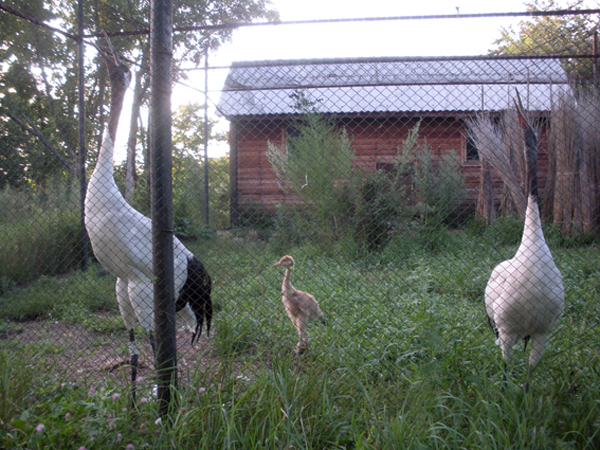Muraviovka Park for Sustainable Land Use was established 20 years ago with ICF’s help in the Amur Region of Russia, to protect important breeding grounds of the endangered Red-crowned and White-naped Cranes. The Park has captive breeding/demonstration facilities for endangered cranes, geese and ducks, a Demonstration Farm, and conducts extensive wildlife research and public education programs. For more information about the Park, visit www.muraviovkapark.ru and www.rbcu.ru. Learn more about ICF’s work in the Amur-Heilong River basin in East Asia.

In 2011 a pair of Red-crowned Cranes kept at Muraviovka Park laid their first eggs! We had been waiting for this day for a few years. The male, Kivili, was four years old in 2008, when a one-year old female, Oka, arrived. Oka grew up in a group of other young cranes, so she ran happily toward Kivili when she was put into the pen with him. Kivili met her with condescending contempt but did not show signs of aggression. Only during feeding times, when Oka would grab a yummy fish ahead of him, did he show aggression.
After the pair bonded, however, Kivili began showing more care toward his mate, and in most cases the birds behaved like a good pair. Then in 2011, Oka finally laid eggs! Suddenly, this well natured bird turned into a mythological fury ready to attack and fight anyone who dared come too close to her nest. And Kivili became even more aggressive than his mate, so that it became dangerous to even deliver food to their pen. With all his might he would rush towards the bird keepers who knew that they had only a few seconds to place the food dish inside the pen and shut the door, to avoid being hurt. Even the broom that the cranes tried to avoid prior to the breeding season did not help any longer. We did not feel safe even behind the closed door that would be hammered by two strong beaks until we walked far away from the pen.
After the first chick hatched in June 2011, its parents became even more intolerant toward anyone who, in their eyes, represented danger to their chick (above, both parents unison call as a warning to stay away from their territory and chick). Still, Kivili was selfish when it came to food. He would always try to be the first to feast on fish and other food of choice, pushing his mate and chick aside. Only when he was full would he let them eat, so several times we had to take the chick out to check his weight while his father was busy with food.
The chick, however, grew well and by mid winter he was taller than his mother. In May 2012 we released him into the wild to replenish the shrinking mainland population of the species.
In spring 2012 Kivili and Oka had entered their second breeding season and we were thrilled to notice the radical change in his behavior. He would still be the first to grab a fish, but instead of swallowing it he would rinse it in the pool and give it to Oka. Only after she had enough, would he begin feeding himself.
By mid June the pair had two beautiful chicks. Kivili, still behaving as furious protector of his family, was now paying much more attention to his chicks’ diet, not only bringing them the best pieces, but also teaching them how to pick insects from the grass and bushes and to find food by pecking the dirt. The character transformation was completed: a selfish Kivili turned into a caring mate and father!
